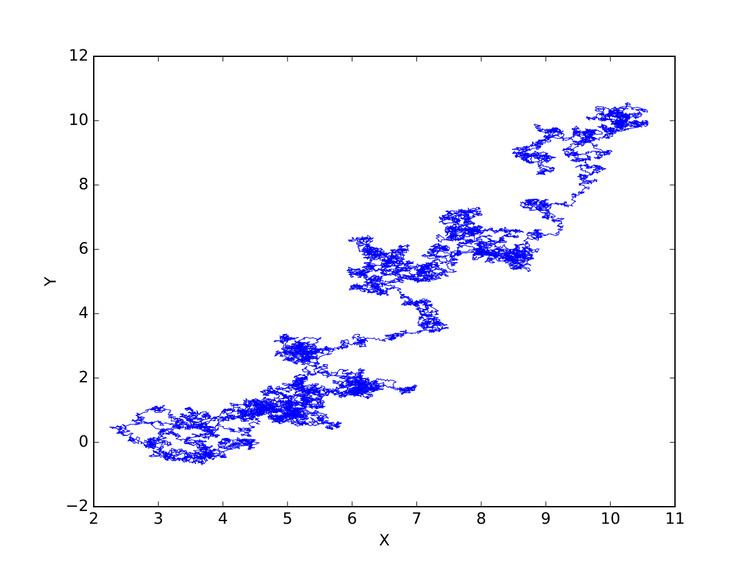 | ||
In mathematics, the Ornstein–Uhlenbeck process (named after Leonard Ornstein and George Eugene Uhlenbeck), is a stochastic process that, roughly speaking, describes the velocity of a massive Brownian particle under the influence of friction. The process is stationary Gauss–Markov process (which means that it is both a Gaussian and Markovian process), and is the only nontrivial process that satisfies these three conditions, up to allowing linear transformations of the space and time variables. Over time, the process tends to drift towards its long-term mean: such a process is called mean-reverting.
Contents
- Representation via a stochastic differential equation
- FokkerPlanck equation representation
- Application in physical sciences
- Application in financial mathematics
- Mathematical properties
- Solution
- Formulas for moments of nonstationary processes
- Alternative representation for nonstationary processes
- Scaling limit interpretation
- Generalizations
- References
The process can be considered to be a modification of the random walk in continuous time, or Wiener process, in which the properties of the process have been changed so that there is a tendency of the walk to move back towards a central location, with a greater attraction when the process is further away from the centre. The Ornstein–Uhlenbeck process can also be considered as the continuous-time analogue of the discrete-time AR(1) process.
Representation via a stochastic differential equation
An Ornstein–Uhlenbeck process, xt, satisfies the following stochastic differential equation:
where
The above representation can be taken as the primary definition of an Ornstein–Uhlenbeck process or sometimes also mentioned as the Vasicek model.
Fokker–Planck equation representation
The probability density function ƒ(x, t) of the Ornstein–Uhlenbeck process satisfies the Fokker–Planck equation
The Green function of this linear parabolic partial differential equation, taking
The stationary solution of this equation is the limit for time tending to infinity which is a Gaussian distribution with mean
Application in physical sciences
The Ornstein–Uhlenbeck process is a prototype of a noisy relaxation process. Consider for example a Hookean spring with spring constant
where
In physical sciences, the stochastic differential equation of an Ornstein–Uhlenbeck process is rewritten as a Langevin equation
where
with correlation time
At equilibrium, the spring stores an average energy
Application in financial mathematics
The Ornstein–Uhlenbeck process is one of several approaches used to model (with modifications) interest rates, currency exchange rates, and commodity prices stochastically. The parameter
Mathematical properties
The Ornstein–Uhlenbeck process is an example of a Gaussian process that has a bounded variance and admits a stationary probability distribution, in contrast to the Wiener process; the difference between the two is in their "drift" term. For the Wiener process the drift term is constant, whereas for the Ornstein–Uhlenbeck process it is dependent on the current value of the process: if the current value of the process is less than the (long-term) mean, the drift will be positive; if the current value of the process is greater than the (long-term) mean, the drift will be negative. In other words, the mean acts as an equilibrium level for the process. This gives the process its informative name, "mean-reverting." The stationary (long-term) variance is given by
The Ornstein–Uhlenbeck process is the continuous-time analogue of the discrete-time AR(1) process.
Asymptotic distribution of the MLE for the Ornstein-Uhlenbeck process:
Solution
This stochastic differential equation is solved by variation of parameters.. Changing variable
we get
Integrating from 0 to t we get
whereupon we see
Formulas for moments of nonstationary processes
From this representation, the first moment is given by (assuming that x0 is a constant)
The Itō isometry can be used to calculate the covariance function by
Alternative representation for nonstationary processes
It is also possible (and often convenient) to represent xt (unconditionally, i.e. as
or conditionally (given x0) as
The time integral of this process can be used to generate noise with a 1/ƒ power spectrum.
Scaling limit interpretation
The Ornstein–Uhlenbeck process can be interpreted as a scaling limit of a discrete process, in the same way that Brownian motion is a scaling limit of random walks. Consider an urn containing
Generalizations
It is possible to extend Ornstein–Uhlenbeck processes to processes where the background driving process is a Lévy process (instead of a simple Brownian motion). These processes are widely studied by Ole Barndorff-Nielsen and Neil Shephard, and others.
In addition, in finance, stochastic processes are used the volatility increases for larger values of
